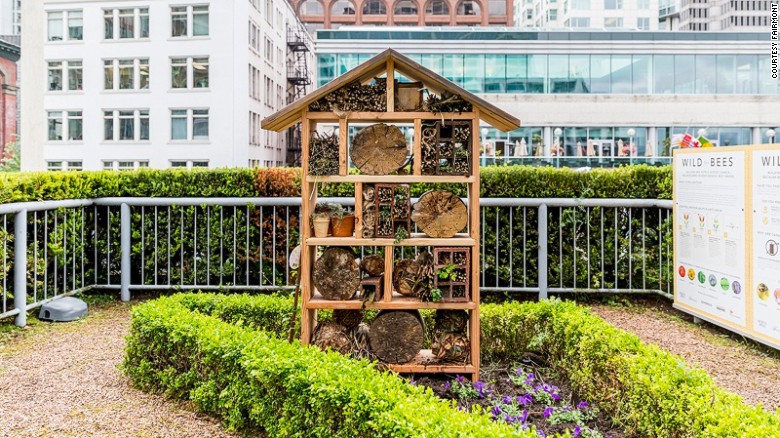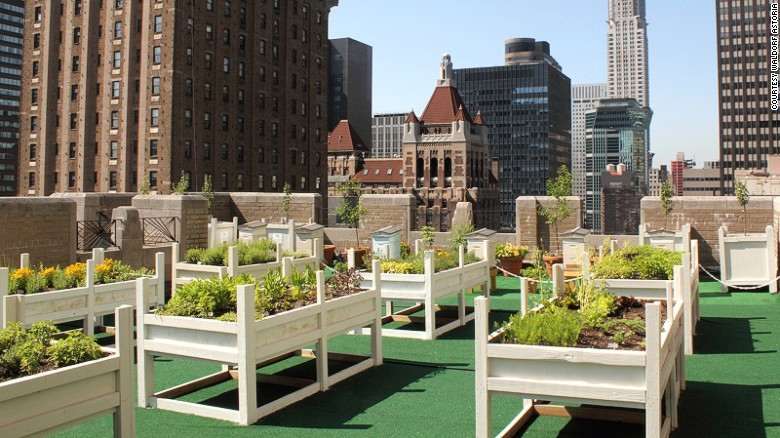Buzz worthy: 5 top luxury hotels that have taken up beekeeping
They're all keepers of honeybees, part of a growing collection of bee-friendly landmarks around the world.
In recent years, global hotels have joined the urban bee-keeping trend too, bringing their own honey direct to their tables.
That's good news, considering the
well documented decline in the bee population in certain geographical areas, notably North America and Europe.
A number of factors, including disease, pesticides and habitat degradation are attributed to
diminishing bee numbers, and the losses are significant.

These
sweet creatures are the globe's most prolific insect pollinators, whose
combined annual economic value to agriculture worldwide is estimated at
$167 billion.
Here's a look at five top
luxury hotels creating a buzz in their local communities.
Waldorf Astoria New York
On
a rooftop 20 stories above Park Avenue, some 360,000 bees produce more
than 136 kilograms (300 pounds) of honey, harvested annually, which not
only finds its way into the hotel's menus, but also into treatments at
the hotel's Guerlain Spa.
"It is an
important statement about our concern for the environment, it is
educational for our culinary team, and it provides fresh fruits,
vegetables, herbs and edible flowers throughout our hotel," says David
Garcelon, director of culinary at Waldorf Astoria New York.
With
home-harvested honey, the hotel created Waldorf Buzz beer last year in
partnership with the Empire brewing Company; a yet-unnamed new brew with
lemon verbena and hops from the on-site garden is slated to be launched
this fall.
Twice weekly, the hotel's
Historical Tour stops off at the garden to see the hives and its more
than 60 types of herbs, fruit, vegetables and edible flowers.
On the menu: The
"Wax Poetic" and "Leaves of Grass" cocktails at Peacock Alley lobby bar
and restaurant are both made with Zubrowka bison grass vodka and
house-made honey syrup.
Mandarin Oriental, Paris
Paris
has been a pesticide-free zone for the past 10 years, making the French
capital an attractive urban environment for honey bees.
With the help of local organization
Apiterra, 50,000 bees reside at the MO rooftop beehive, with last year's sweet haul totaling 25 kilograms.
Guests
who can't get enough of the ooey, gooey and very sweet syrup (in the
words of Winnie the Pooh) offered through the hotel's F&B menu can
opt into the hotel's eco-initiatives -- such as reusing towels -- to
receive a jar of honey to keep.
On the menu: The "Homemade Honey" cocktail at Bar 8 is made with Yuzu liqueur, jasmine tea with ginger, Champagne and house-made honey.
Following
a good eight months of prep work, W Taipei became the first urban
beekeeping establishment in Taiwan when it opened up its 32nd floor
rooftop to host some 150,000 busy bees in partnership with Syin Lu
Social Welfare Foundation.
After six
months and two harvests from the Sweet Reward program, the bee colonies
were moved to another downtown building as part of the foundation's
larger urban beekeeping project.
Whatever
honey the hotel chefs and mixologists don't purchase from Syin Lu, the
foundation (which produced more than 800 kilograms of honey in the first
half of the year from 94 hives) either sells or produces soaps with it
in their factory manned by disabled workers.
On the menu:
The "Detox Martini" cocktail at WOOBAR is made with green tea-infused
Belvedere vodka, Grand Marnier, orange juice, yuzu juice, house-made
honey and Sprite.
Fairmont Waterfront, Vancouver

From
May to September, Fairmont Waterfront guests can join a daily tour of
the apiary and rooftop garden with a resident bee butler.
The
pioneer of in-house honeybee production and supporting global bee
health is Fairmont Hotels & Resorts, whose Bee Sustainable program
comprises honeybee apiaries at more than 20 properties across the world.
"By building more than a dozen luxury
bee hotels from coast to coast, we are doing our part to build a more
sustainable world," says Jane Mackie, Fairmont Brand vice president.
In
June this year, the Fairmont Waterfront became one of the first hotels
in the group to build a solitary pollinator bee hotel (aptly named Bee
& Bee) designed to give busy bees a break between pollination
missions.
The hotel also hosts 500,000
resident honeybees in the 195 square meter herb garden on the third
floor terrace, which forage over 67 square kilometers and 60 different
plants (particular favorites being the pollens from blackberry blossoms
and American bamboo blossoms).
From May
to September, guests can join a daily tour of the apiary and rooftop
garden with a resident bee butler (and have a sneak peek at the bees
from the observation hive). Guests can also request to go on a
Pollinator Corridor Walk through the city with Hives for Humanity's
Julia Common.
On the menu:
The "Waterfront Bee's Knees" cocktail at ARC Bar is made with Bombay
Sapphire Gin, lemon juice, house-made honey syrup and topped with Earl
Grey tea foam.
St. Ermin's Hotel, London
St.
Ermin's has been keeping bees for some four years now, first on the
main rooftop and later expanding the installation to include a specially
planted wildflower terrace where a new bee hotel -- the first hotel in
the UK to have one -- now resides.
The
hotel had their own honey analyzed, with results showing their bees
gather nectar from over 50 different plants and trees within their
three-mile forage radius (which includes Buckingham Palace Gardens and
St. James' Park).
September is the
hotel's annual honey month, when they celebrate their house-made amber
nectar through all of the food and cocktail menus. During the same
month, the hotel also hosts an urban beekeeping workshop with their
expert beekeeper, Camilla Goddard of Capital Bee.
On the menu: The 'Bowler Hat' cocktail at Caxton Bar is made with dry vermouth, London gin, raw house-made honey and lemon juice.











































